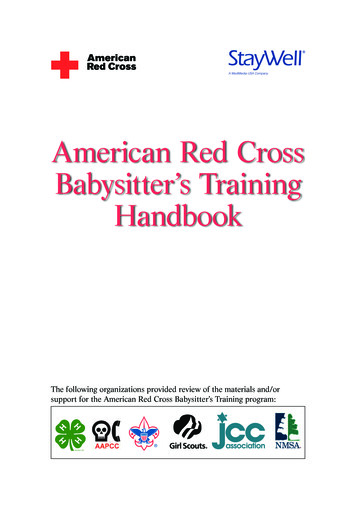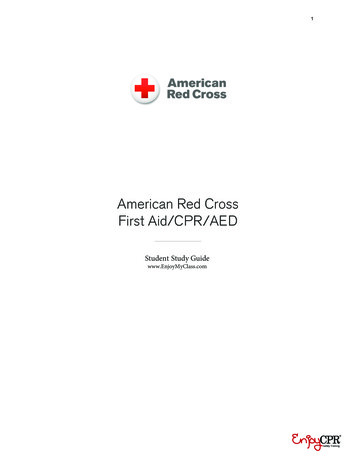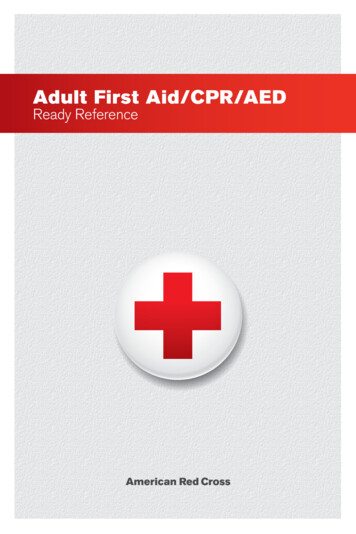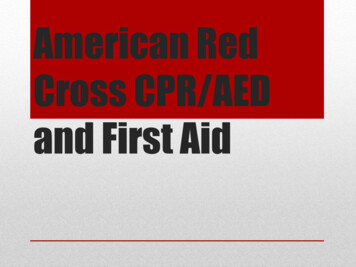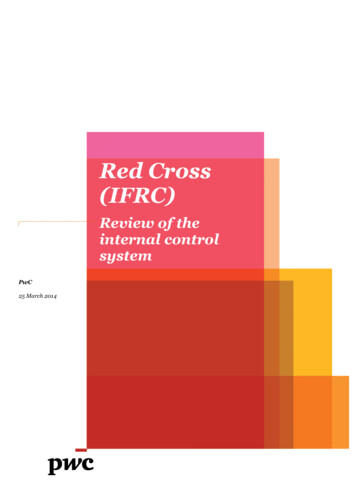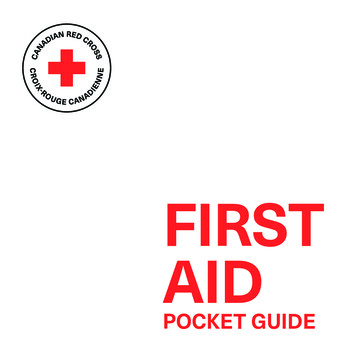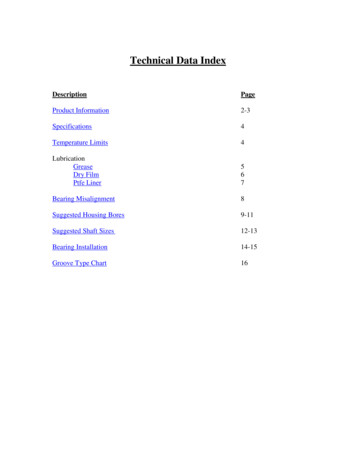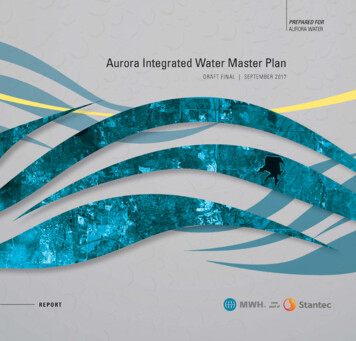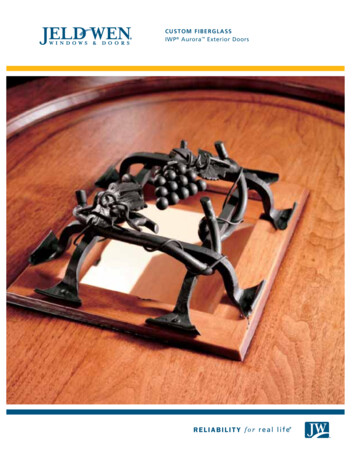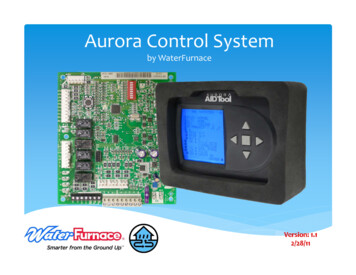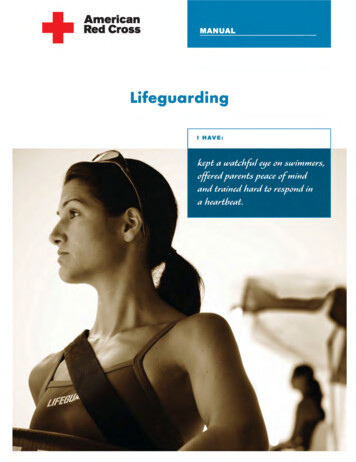
Transcription
Expand Your Employment Skills with Training fromthe American Red CrossBecome a Water Safety Instructor TodayEach year, the American RedCross teaches more than2 million children and adults toswim thanks to people just likeyou. Individuals 16 and oldercan become certified to teachthe Red Cross Swimming andWater Safety program withonly 30 hours of training. Plus,Red Cross certification isrecognized nationwide, so youcan work wherever you go.Build Skills to Last a LifetimeBuilding leadership, communication and teaching skills willnot only help you in the summer job market, but also for therest of your life. Through video and hands-on skill building,the course features clearly described and applied teachingstrategies. The Red Cross provides you with the highestquality training and the best tools available so you canbecome a top-notch instructor.Fun Jobs that Help Save LivesAs a Water Safety Instructor, you will teach people of allages and skill levels how to be safe in, on and around thewater. Your certification will allow you to teach— Learn-to-Swim (Levels 1–6). Parent and Child Aquatics. A variety of water safety presentations.For more information on becoming a Water Safety Instructorin your community, contact your local American Red Crosschapter, call (800) RED-CROSS or visit www.redcross.org.
LifeguardingThe following organizations provided review of the materials and support for American Red Cross Lifeguarding:
Copyright 2007 by The American National Red CrossAll rights reserved. No part of this publication may be reproduced, stored in a retrieval system or transmitted in any form or by any means, electronic, mechanical,photocopying, recording or otherwise, without prior permission from American RedCross National Headquarters, Preparedness and Health and Safety Services.Content reflects the American Red Cross 2005 Guidelines for Emergency Care andEducation and the 2005 Guidelines for First Aid.American Red Cross certificates may be issued upon successful completion of atraining program, which uses this manual as an integral part of a course. By itself,the material in this manual does not constitute comprehensive Red Cross training.In order to issue Red Cross certificates, your instructor must be authorized by theAmerican Red Cross, and must follow prescribed policies and procedures. Makecertain that you have attended a course authorized by the Red Cross. Contact yourlocal American Red Cross chapter (www.redcross.org) for more information.The emergency care procedures outlined in this manual reflect the standard ofknowledge and accepted emergency practices in the United States at the time thismanual was published. It is the reader’s responsibility to stay informed of changesin the emergency care procedures.The Girl Scout service mark is a registered trademark of Girl Scouts of the USA.Printed by Banta Book Group.StayWell780 Township Line Rd.Yardley, PA 19067Library of Congress Cataloging-in-Publication DataLifeguarding. — 3rd ed.p. cm.Includes bibliographical references and index.ISBN 1-58480-320-71. Lifesaving. 2. Lifeguards—Training of. I. American Red Cross.GV838.7.L54 2007797.2 10289—dc222006031662ISBN-10 1-58480-320-7ISBN-13 978-1-58480-320-110/ 9 8 7 6 5
AcknowledgmentsACKNOWLEDGMENTSAmerican Red Cross Lifeguarding was developed through the dedication of both employees and volunteers. Theircommitment to excellence made this manual possible.The American Red Cross team forthis edition included—Pat BoniferDirectorResearch and Product DevelopmentJennifer DeibertProject ManagerResearch and Product DevelopmentMike EspinoProject Manager, Aquatics TechnicalDevelopmentResearch and Product DevelopmentGreta PetrillaManagerCommunication and MarketingMary Kate MartelonVolunteer InternResearch and Product DevelopmentBetty J. ButlerAdministrative AssistantResearch and Product DevelopmentRhadames AvilaAdministrative AssistantResearch and Product DevelopmentKelly FischbeinAssociate, EvaluationResearch and Product DevelopmentGuidance and support was providedby the following individuals—Connie HarveyManagerResearch and Product DevelopmentScott ConnerVice PresidentPreparedness and Health and SafetyServicesJohn HendricksonSenior AssociateChapter Business Development andSales SupportTom HeneghanSenior AssociateProgram Administration and SupportSteve LynchSenior AssociateBusiness PlanningMarc MaddenSenior AssociateResearch and Product DevelopmentBarbara MuthManager, EvaluationResearch and Product DevelopmentLindsay Oaksmith, CHESSenior Associate, Aquatics TechnicalDevelopmentResearch and Product DevelopmentDon VardellNational ChairPreparedness and Health and SafetyServicesThe StayWell team for this editionincluded—Nancy MonahanSenior Vice PresidentBill WinnebergerSenior Director of ManufacturingPaula BattExecutive DirectorSales and Business DevelopmentReed KlanderudExecutive DirectorMarketing and New ProductDevelopmentShannon BatesManaging EditorLorraine P. CoffeySenior Developmental EditorBryan ElrodSenior Developmental EditorKate PlourdeMarketing ManagerStephanie WeidelSenior Production EditorThe following members of the American Red Cross Advisory Council onFirst Aid and Safety (ACFAS) alsoprovided guidance and review:David Markenson, MD, FAAP, EMT-PChair, American Red Cross AdvisoryCouncil on First Aid and Safety(ACFAS)Chief, Pediatric Emergency MedicineMaria Fareri Children’s HospitalWestchester Medical CenterValhalla, New YorkRoy R. FieldingMember, American Red CrossLifeguarding Advisory GroupUniversity of North Carolina—Charlotte, Dept. of KinesiologyDirector of AquaticsCharlotte, North CarolinaFrancesco A. Pia, PhDMember, American Red CrossLifeguarding Advisory GroupWater Safety Films, Inc.President, Pia Consulting ServicesLarchmont, New YorkM. Kathryn ScottDirector, Physical EducationUniversity of CaliforniaBerkeley, Californiaiii
ivAcknowledgmentsThe Lifeguarding Advisory Group forthis edition included—Joyce A. BathkeAmerican Red CrossSt. Louis Area ChapterDirector, Health and SafetySt. Louis, MissouriDavid W. Bell, PhDNational Aquatic CommitteeNational Health and SafetyCommitteeBoy Scouts of AmericaPonca City, OklahomaTina M. DittmarCity of Laguna Niguel, Parks &Recreation AquaticsAquatics SupervisorLaguna Niguel, CaliforniaDan L. JonesCity of Newport News—Aquatics andBeach SafetyDirector, Aquatics and Beach SafetyNewport News, VirginiaJohn A. KaufmannUnited States NavySupervisor Training SpecialistPensacola, FloridaBryan J. NadeauBusch Entertainment CorporationAdmission Systems ManagerSt. Louis, MissouriJorge L. Olaves, EdSFlorida A&M University—AquaticCenterAquatic Director/CoordinatorTallahassee, FloridaThe following organizations provided external review:American Camp Association—EducationCatherine M. SchederDirector, Educational PartnershipsMartinsville City, IndianaBoy Scouts of America—NationalCouncilBill SteeleDirectorLeadership Support ServiceIrving, TexasBoys & Girls Clubs of AmericaRachel C. FalgoutDirector, Teen ServicesAtlanta, GeorgiaGirl Scouts of the U.S.A.Kathleen M. CullinanProgram Consultant, Safety-WiseLeadNew York, New YorkJewish Community CentersAssociationJoyAnn BrandAssociate Director of ProfessionalDevelopmentNew York, New YorkNational Recreation & ParkAssociationSharon L. MannionAquatic ManagerAshburn, VirginiaUS Navy—CNIC—MWR—MissionEssential BranchJohn K. PowellHead, Mission Essential BranchMillington, TennesseeUSA SwimmingSue Pitt AndersonResource DevelopmentColorado Springs, ColoradoThe following individuals providedexternal review:Gerald DeMers, PhDChair, Kinesiology DepartmentCalifornia Polytechnic StateUniversitySan Luis Obispo, CaliforniaJennifer Espino-SmithSupervisory Recreation Specialist30th Services DivisionVandenberg AFB, CaliforniaJim O’ConnorAquatics CoordinatorMiami-Dade Park and RecreationMiami, FloridaThe following individuals providedexternal review for American RedCross and StayWell:Susan T. Dempf, PhDAssociate Professor, The Sage CollegesTroy, New YorkTerri Eudy, MAHealth and Safety CourseInstructor/TrainerDepartment of Campus RecreationOakland UniversityRochester, MichiganBonnie GriswoldAquatics SupervisorCity of MadisonMadison, WisconsinThe American Red Cross and StayWell thank Casey Berg, Rick Brady,Vincent Knaus, Jessica Silver and LynnWhittemore for their contributions tothe development of this manual.
AcknowledgmentsPhoto LocationsA.D. Barnes PoolMetro-Dade Parks and RecreationMiami, FloridaAnacostia PoolDistrict of ColumbiaDepartment of Parks and RecreationWashington, DCArmy Navy Country ClubArlington, VirginiaCamp OnekaWayne, PennsylvaniaCamp SaffranBroad Creek Memorial ScoutReservationBaltimore Area Council, Boy Scoutsof AmericaWhiteford, MarylandCarpinteria Community PoolCity of CarpinteriaParks and RecreationCarpinteria, CaliforniaCrown Valley Community PoolCity of Laguna NiguelParks & RecreationLaguna Niguel, CaliforniaCypress LakesLee County Parks and RecreationFort Myers, FloridaGunpowder Falls State ParkHammerman AreaChase, MarylandHuntington Park BeachCity of Newport NewsDepartment of Parks, Recreation &TourismNewport News, VirginiaLarry and Penny Thompson ParkMetro-Dade Parks and RecreationMiami, FloridaLos Baños PoolCity of Santa BarbaraParks & RecreationSanta Barbara, CaliforniaMagruder Swimming PoolCity of Newport NewsDepartment of Parks, Recreation &TourismNewport News, VirginiaMatheson Hammock ParkMetro-Dade Parks and RecreationMiami, FloridaMidtown Aquatic CenterCity of Newport NewsDepartment of Parks, Recreation &TourismNewport News, VirginiaNorth Shore PoolReston AssociationReston, VirginiaPaul Nelson Aquatic CenterCity of Santa MariaRecreation & Parks DepartmentSanta Maria, CaliforniaTurkey Thicket PoolDistrict of ColumbiaDepartment of Parks and RecreationWashington, DCUniversity of MarylandCampus Recreation CenterNatatoriumCollege Park, MarylandVandenberg AFB Family AquaticCenter30th Services DivisionVandenberg AFB, CaliforniaVentura Aquatic CenterCity of VenturaCommunity Recreation DivisionVentura, CaliforniaWalt Disney WorldOrlando, FloridaWet ‘n WildOrlando, FloridaWild Rivers WaterparkIrvine, CaliforniaWilliam Woollett Jr. Aquatics CenterCity of IrvineCommunity ServicesIrvine, Californiav
viPrefacePREFACEThis manual is for lifeguards, whom the American Red Cross profoundly thanks for theircommitment to safeguarding the lives of children and adults who enjoy aquatic facilities.As the number of community pools and waterparks grows nationwide, participation inaquatic activities is also growing. With this growth comes the need for even more lifeguards.To protect this growing number of participants, lifeguards must receive proper and effective training. Lifeguards also need to maintain their skills to ensure their ability towork effectively with others as a part of a lifeguard team. Participation in frequent andongoing training is essential.Lifeguards must be able to recognize hazardous situations to prevent injury. They must beable to supervise swimmers, minimize dangers, educate facility users about safety, enforce rules and regulations, provide assistance and perform rescues.Being a lifeguard carries a significant professional responsibility, but lifeguarding also offers opportunities for personal growth. Experience as a lifeguard can help one developprofessional and leadership skills that will last a lifetime—through college, career andfamily.There are a half million American Red Cross-trained lifeguards working at swimming pools,waterparks and waterfronts across our country. Every day on the job, these lifeguards arepart of a critical force for good—ensuring the safety of patrons and protecting lives.
Brief Table of ContentsBRIEF TABLE OF CONTENTSChapter 1The Professional Lifeguard . . . . . . . . . . . . . . . . . . . . . . . . . . . . . . . . 1Chapter 2Injury Prevention and Facility Safety . . . . . . . . . . . . . . . . . . . . . . . 11Patron Surveillance . . . . . . . . . . . . . . . . . . . . . . . . . . . . . . . . . . . . . 27Emergency Preparation . . . . . . . . . . . . . . . . . . . . . . . . . . . . . . . . . . 49Chapter 3Chapter 4Chapter 5Chapter 6Chapter 7Chapter 8Chapter 9Chapter 10Chapter 11Rescue Skills . . . . . . . . . . . . . . . . . . . . . . . . . . . . . . . . . . . . . . . . . . . 57Before Providing Care and Victim Assessment . . . . . . . . . . . . . . 85Breathing Emergencies . . . . . . . . . . . . . . . . . . . . . . . . . . . . . . . . . 101Cardiac Emergencies . . . . . . . . . . . . . . . . . . . . . . . . . . . . . . . . . . . 123First Aid . . . . . . . . . . . . . . . . . . . . . . . . . . . . . . . . . . . . . . . . . . . . . . 141Caring for Head, Neck and Back Injuries . . . . . . . . . . . . . . . . . . 159The Benefits of Lifeguarding . . . . . . . . . . . . . . . . . . . . . . . . . . . . . 181vii
viiiTable of ContentsTABLE OF CONTENTSChapter 1Chapter 4The Professional Lifeguard . . . . . . . . . . . . . . . . 1Emergency Preparation . . . . . . . . . . . . . . . . . . 49Characteristics of a Professional Lifeguard . . . . . . . 2Responding to Emergencies . . . . . . . . . . . . . . . . . . 50Responsibilities of a Professional Lifeguard . . . . . . 3Emergency Action Plans . . . . . . . . . . . . . . . . . . . . . 50Lifeguard Work Settings . . . . . . . . . . . . . . . . . . . . . . . 4After an Emergency . . . . . . . . . . . . . . . . . . . . . . . . . 53Decision Making . . . . . . . . . . . . . . . . . . . . . . . . . . . . . 6Putting it All Together . . . . . . . . . . . . . . . . . . . . . . . . 56Legal Considerations . . . . . . . . . . . . . . . . . . . . . . . . . 6The Lifeguard Team . . . . . . . . . . . . . . . . . . . . . . . . . . 8How Facility Management PromotesLifeguard Professionalism . . . . . . . . . . . . . . . . . . . 8Chapter 5Maintaining Lifeguarding Knowledge and Skills . . . 9Rescue Skills . . . . . . . . . . . . . . . . . . . . . . . . . . . 57Putting it All Together . . . . . . . . . . . . . . . . . . . . . . . . 10General Procedures for a Water Emergency . . . . . 58Rescue Equipment . . . . . . . . . . . . . . . . . . . . . . . . . . 58Entries . . . . . . . . . . . . . . . . . . . . . . . . . . . . . . . . . . . . 59Chapter 2Rescue Approaches . . . . . . . . . . . . . . . . . . . . . . . . . 62Assists . . . . . . . . . . . . . . . . . . . . . . . . . . . . . . . . . . . . 62Injury Prevention and Facility Safety . . . . . . 11Rescues at or Near the Surface . . . . . . . . . . . . . . . 64Preventing Injuries: Patron Safety . . . . . . . . . . . . . 12Rescuing a Submerged Victim . . . . . . . . . . . . . . . . . 66Communication with Patrons . . . . . . . . . . . . . . . . . . 12Escapes . . . . . . . . . . . . . . . . . . . . . . . . . . . . . . . . . . . 68Enforce Rules and Regulations . . . . . . . . . . . . . . . . 18Multiple-Victim Rescue . . . . . . . . . . . . . . . . . . . . . . 70Safety Checks . . . . . . . . . . . . . . . . . . . . . . . . . . . . . . 18Removal from Water . . . . . . . . . . . . . . . . . . . . . . . . . 71Weather Conditions . . . . . . . . . . . . . . . . . . . . . . . . . 21Additional Rescue Skills at Waterfronts . . . . . . . . . 74Management and Safety . . . . . . . . . . . . . . . . . . . . . 23Special Situations at Waterfronts . . . . . . . . . . . . . . 78Putting it All Together . . . . . . . . . . . . . . . . . . . . . . . . 26Putting it All Together . . . . . . . . . . . . . . . . . . . . . . . . 84Chapter 3Patron Surveillance . . . . . . . . . . . . . . . . . . . . . 27Chapter 6Effective Surveillance . . . . . . . . . . . . . . . . . . . . . . . . 28Before Providing Care and VictimAssessment . . . . . . . . . . . . . . . . . . . . . . . . . . . . 85Effective Scanning . . . . . . . . . . . . . . . . . . . . . . . . . . 31Before Providing Care . . . . . . . . . . . . . . . . . . . . . . . 86Special Considerations for Patron Surveillance . . 38Bloodborne Pathogens . . . . . . . . . . . . . . . . . . . . . . . 86Putting it All Together . . . . . . . . . . . . . . . . . . . . . . . . 48How Pathogens Spread . . . . . . . . . . . . . . . . . . . . . . 87Preventing the Spread of BloodbornePathogens . . . . . . . . . . . . . . . . . . . . . . . . . . . . . . . 89
Table of ContentsIf Exposed to Infectious Material . . . . . . . . . . . . . . 94General Procedures for Injury or SuddenIllness on Land . . . . . . . . . . . . . . . . . . . . . . . . . . . 94Chapter 10Emergency Moves . . . . . . . . . . . . . . . . . . . . . . . . . . 98Caring for Head, Neck and Back Injuries . . 159Putting it All Together . . . . . . . . . . . . . . . . . . . . . . . 100Causes of Head, Neck and Back Injuries . . . . . . . 160Caring for Head, Neck and Back Injuries . . . . . . . 160Chapter 7Breathing Emergencies . . . . . . . . . . . . . . . . . 101Breathing Emergencies . . . . . . . . . . . . . . . . . . . . . 102Caring for Head, Neck and Back Injuriesin the Water . . . . . . . . . . . . . . . . . . . . . . . . . . . . . 160Head, Neck and Back Injuries on Land . . . . . . . . 177Putting it All Together . . . . . . . . . . . . . . . . . . . . . . . 180Rescue Breathing . . . . . . . . . . . . . . . . . . . . . . . . . . 104Airway Obstruction . . . . . . . . . . . . . . . . . . . . . . . . . 111Emergency Oxygen . . . . . . . . . . . . . . . . . . . . . . . . . 116Chapter 11Oxygen Delivery Devices . . . . . . . . . . . . . . . . . . . . 118The Benefits of Lifeguarding . . . . . . . . . . . . . 181Oxygen Administration . . . . . . . . . . . . . . . . . . . . . . 119Personal Benefits . . . . . . . . . . . . . . . . . . . . . . . . . . 182Putting it All Together . . . . . . . . . . . . . . . . . . . . . . . 122Professional Benefits . . . . . . . . . . . . . . . . . . . . . . . 182Putting it All Together . . . . . . . . . . . . . . . . . . . . . . . 183Chapter 8Cardiac Emergencies . . . . . . . . . . . . . . . . . . . 123Cardiac Chain of Survival . . . . . . . . . . . . . . . . . . . . 124CPR . . . . . . . . . . . . . . . . . . . . . . . . . . . . . . . . . . . . . . 126AEDs . . . . . . . . . . . . . . . . . . . . . . . . . . . . . . . . . . . . . 133Putting it All Together . . . . . . . . . . . . . . . . . . . . . . . 139Chapter 9First Aid . . . . . . . . . . . . . . . . . . . . . . . . . . . . . . 141Secondary Assessment . . . . . . . . . . . . . . . . . . . . . 142Sudden Illness . . . . . . . . . . . . . . . . . . . . . . . . . . . . . 145Bites and Stings . . . . . . . . . . . . . . . . . . . . . . . . . . . 147Poisoning . . . . . . . . . . . . . . . . . . . . . . . . . . . . . . . . . 148Wounds . . . . . . . . . . . . . . . . . . . . . . . . . . . . . . . . . . 149Injuries to Muscles, Bones and Joints . . . . . . . . . 155Heat- and Cold-Related Emergencies . . . . . . . . . . 157Putting it All Together . . . . . . . . . . . . . . . . . . . . . . . 158Glossary . . . . . . . . . . . . . . . . . . . . . . . . . . . . . . 185References . . . . . . . . . . . . . . . . . . . . . . . . . . . . 191Index . . . . . . . . . . . . . . . . . . . . . . . . . . . . . . . . . 195ix
external review for American Red Cross and StayWell: Susan T. Dempf, PhD Associate Professor, The Sage Colleges Troy, New York Terri Eudy, MA Health and Safety Course Instructor/Trainer Department of Campus Recreation Oakland University Rochester, Michigan Bonnie Griswold Aquatics Supervisor City of Madison
